
Pouteria is a genus of flowering trees in the gutta-percha family, Sapotaceae. The genus is widespread throughout the tropical Americas, with outlier species in Cameroon and Malesia. It includes the canistel, the mamey sapote, and the lucuma. Commonly, this genus is known as pouteria trees, or in some cases, eggfruits.
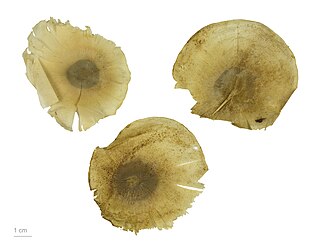
Aspidosperma is a genus of flowering plant in the family Apocynaceae, first described as a genus in 1824. It is native to South America, Central America, southern Mexico, and the West Indies.

Micropholis is genus of trees in the family Sapotaceae, described in 1891.
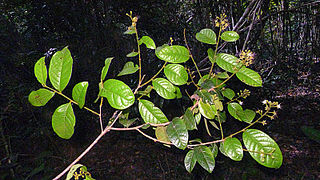
Hirtella is a genus of 110 species of woody trees in family Chrysobalanaceae. It was first described as a genus by Linnaeus in 1753. Hirtella naturally occurs in tropical forests throughout Latin America, the West Indies, southeast Africa, and Madagascar. The flowers are mainly pollinated by butterflies.
Calonotos is a genus of moths in the subfamily Arctiinae. The genus was erected by Jacob Hübner in 1819.

Mechanitis polymnia, the orange-spotted tiger clearwing or disturbed tigerwing, is a butterfly of the family Nymphalidae. It is found from Mexico to the Amazon rainforest. The wingspan is 65–75 mm (2.6–3.0 in). The larvae feed on Solanum species.

Ectomis is a genus of Neotropical and Nearctic butterflies in the family Hesperiidae (Eudaminae).

Olyra is a genus of tropical bamboos in the grass family. It is native primarily to the Western Hemisphere, with one species extending into Africa.

Marpesia is a butterfly genus in the family Nymphalidae. The species of this genus are found in the Neotropical and Nearctic realms.

Cithaerias is a Neotropical butterfly genus from the subfamily Satyrinae in the family Nymphalidae.

Cithaerias pireta, the blushing phantom, is a species of butterfly of the family Nymphalidae. It is found from Mexico south to South America.

Heliconius numata, the Numata longwing, is a brush-footed butterfly species belonging to the family Nymphalidae, subfamily Heliconiinae.

Haetera piera, the amber phantom, is a butterfly species from the subfamily Satyrinae in the family Nymphalidae. This species can be found in the Guianas, Brazil, Ecuador, Peru, Bolivia and Venezuela.

Ceratinia neso, the Neso tigerwing, is a species of butterfly of the family Nymphalidae. It is found in South America.
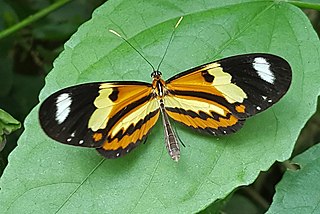
Mechanitis lysimnia, the confused tigerwing, sweet-oil tiger or lysimnia tigerwing, is a species of butterfly of the family Nymphalidae. It was described by Johan Christian Fabricius in 1793. It is found in Central and South America, from southern Mexico to Uruguay. The habitat consists of disturbed forests at altitudes up to 1,500 metres (4,900 ft).
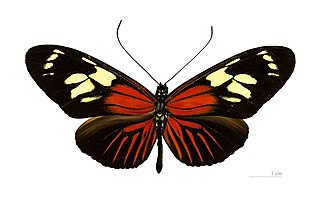
Heliconius burneyi, the Burney's longwing, is a butterfly of the family Nymphalidae. It was described by Jacob Hübner in 1831. It is found in the Amazon basin. The habitat consists of tall forests.

Heliconius ethilla, the ethilia longwing, is a butterfly of the family Nymphalidae. It was described by Jean-Baptiste Godart in 1819. It is found from Panama to southern Brazil. The habitat consists of marginal forests.
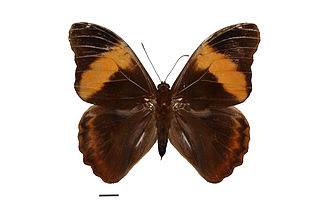
Selenophanes cassiope, the cassiope owlet, is a butterfly of the family Nymphalidae. It was described by Pieter Cramer in 1775. It is found from Colombia through the Guianas to south-eastern Brazil.
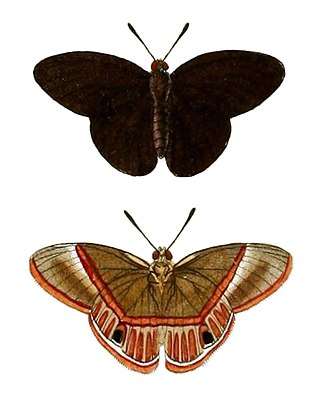
Euselasia is a genus of butterflies in the family Riodinidae. They are present only in the Neotropical realm. The genus was erected by Jacob Hübner in 1819.
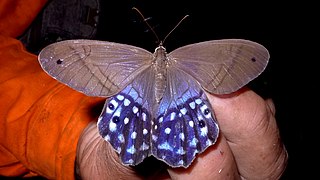
Pierella lena, the Lena pierella, is a species of butterfly of the family Nymphalidae. It is found in Suriname, the Guianas, Peru, Bolivia and Brazil.

















